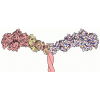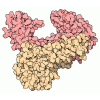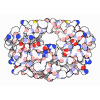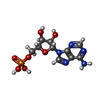+ Open data
Open data
- Basic information
Basic information
| Entry |  | |||||||||
|---|---|---|---|---|---|---|---|---|---|---|
| Title | The ligation (AMP-Lys) complex in the NHEJ pathway | |||||||||
 Map data Map data | consensus map for Ligation complex (AMP-Lys) in NHEJ pathway | |||||||||
 Sample Sample |
| |||||||||
 Keywords Keywords | NHEJ / ligation / XLF / PAXX / DNA repair / Ligase IV / LIGASE-TRANSFERASE-DNA complex | |||||||||
| Function / homology |  Function and homology information Function and homology informationFHA domain binding / positive regulation of chromosome organization / positive regulation of ligase activity / DNA ligase IV complex / DNA ligase activity / Ku70:Ku80 complex / DN2 thymocyte differentiation / negative regulation of t-circle formation / DNA ligase (ATP) / T cell receptor V(D)J recombination ...FHA domain binding / positive regulation of chromosome organization / positive regulation of ligase activity / DNA ligase IV complex / DNA ligase activity / Ku70:Ku80 complex / DN2 thymocyte differentiation / negative regulation of t-circle formation / DNA ligase (ATP) / T cell receptor V(D)J recombination / DNA end binding / pro-B cell differentiation / small-subunit processome assembly / positive regulation of lymphocyte differentiation / DNA ligase (ATP) activity / DNA-dependent protein kinase complex / DNA-dependent protein kinase-DNA ligase 4 complex / nonhomologous end joining complex / immunoglobulin V(D)J recombination / nucleotide-excision repair, DNA gap filling / single strand break repair / regulation of smooth muscle cell proliferation / cellular response to X-ray / V(D)J recombination / nuclear telomere cap complex / double-strand break repair via classical nonhomologous end joining / protein localization to site of double-strand break / isotype switching / Cytosolic sensors of pathogen-associated DNA / IRF3-mediated induction of type I IFN / positive regulation of neurogenesis / regulation of telomere maintenance / recombinational repair / U3 snoRNA binding / protein localization to chromosome, telomeric region / DNA biosynthetic process / response to ionizing radiation / cellular response to lithium ion / cellular hyperosmotic salinity response / 2-LTR circle formation / telomeric DNA binding / hematopoietic stem cell proliferation / ligase activity / positive regulation of protein kinase activity / site of DNA damage / Lyases; Carbon-oxygen lyases; Other carbon-oxygen lyases / T cell differentiation / somatic stem cell population maintenance / 5'-deoxyribose-5-phosphate lyase activity / response to X-ray / hematopoietic stem cell differentiation / ATP-dependent activity, acting on DNA / chromosome organization / telomere maintenance via telomerase / SUMOylation of DNA damage response and repair proteins / condensed chromosome / DNA polymerase binding / neurogenesis / cellular response to ionizing radiation / telomere maintenance / activation of innate immune response / DNA helicase activity / cyclin binding / cellular response to leukemia inhibitory factor / B cell differentiation / central nervous system development / stem cell proliferation / response to gamma radiation / small-subunit processome / Nonhomologous End-Joining (NHEJ) / enzyme activator activity / cellular response to gamma radiation / protein-DNA complex / base-excision repair / double-strand break repair via nonhomologous end joining / Hydrolases; Acting on acid anhydrides; Acting on acid anhydrides to facilitate cellular and subcellular movement / establishment of integrated proviral latency / fibrillar center / positive regulation of fibroblast proliferation / site of double-strand break / double-strand break repair / T cell differentiation in thymus / double-stranded DNA binding / neuron apoptotic process / scaffold protein binding / fibroblast proliferation / secretory granule lumen / DNA recombination / molecular adaptor activity / transcription regulator complex / damaged DNA binding / in utero embryonic development / ficolin-1-rich granule lumen / negative regulation of neuron apoptotic process / chromosome, telomeric region / cell population proliferation / transcription cis-regulatory region binding / ribonucleoprotein complex / innate immune response / cell division Similarity search - Function | |||||||||
| Biological species |  Homo sapiens (human) Homo sapiens (human) | |||||||||
| Method | single particle reconstruction / cryo EM / Resolution: 3.3 Å | |||||||||
 Authors Authors | Li J / Liu L / Gellert M / Yang W | |||||||||
| Funding support |  United States, 1 items United States, 1 items
| |||||||||
 Citation Citation |  Journal: Nature / Year: 2025 Journal: Nature / Year: 2025Title: Dynamic assemblies and coordinated reactions of non-homologous end joining. Authors: Lan Liu / Jun Li / Metztli Cisneros-Aguirre / Arianna Merkell / Jeremy M Stark / Martin Gellert / Wei Yang /  Abstract: Non-homologous end joining (NHEJ) is the main repair pathway of double-strand DNA breaks in higher eukaryotes. Here we report reconstitution of the final steps of NHEJ and structures of DNA ...Non-homologous end joining (NHEJ) is the main repair pathway of double-strand DNA breaks in higher eukaryotes. Here we report reconstitution of the final steps of NHEJ and structures of DNA polymerase μ and ligase IV (LIG4) engaged in gap filling and end joining. These reactions take place in a flexible ω-shaped framework composed of XRCC4 and XLF. Two broken DNA ends, each encircled by Ku70-Ku80 internally, are docked onto the ω frame, mediated by LIG4. DNA polymerase and ligase attached to each ω arm repair only one broken strand of a defined polarity; the final steps of NHEJ requires coordination and toggling of a pair of such enzymes. The facilitators XLF and PAXX additively stimulate NHEJ reactions. As DNA-end sensor and protector, LIG4 replaces DNA-PKcs for end joining and bridges the two DNA ends for polymerase to fill remaining gaps. These assemblies present new targets for NHEJ inhibition to enhance efficacy of radiotherapy and accuracy of gene editing. | |||||||||
| History |
|
- Structure visualization
Structure visualization
- Downloads & links
Downloads & links
-EMDB archive
| Map data |  emd_49109.map.gz emd_49109.map.gz | 243.9 MB |  EMDB map data format EMDB map data format | |
|---|---|---|---|---|
| Header (meta data) |  emd-49109-v30.xml emd-49109-v30.xml emd-49109.xml emd-49109.xml | 40.5 KB 40.5 KB | Display Display |  EMDB header EMDB header |
| FSC (resolution estimation) |  emd_49109_fsc.xml emd_49109_fsc.xml | 18.1 KB | Display |  FSC data file FSC data file |
| Images |  emd_49109.png emd_49109.png | 98.5 KB | ||
| Masks |  emd_49109_msk_1.map emd_49109_msk_1.map | 512 MB |  Mask map Mask map | |
| Filedesc metadata |  emd-49109.cif.gz emd-49109.cif.gz | 9.6 KB | ||
| Others |  emd_49109_additional_1.map.gz emd_49109_additional_1.map.gz emd_49109_additional_2.map.gz emd_49109_additional_2.map.gz emd_49109_additional_3.map.gz emd_49109_additional_3.map.gz emd_49109_half_map_1.map.gz emd_49109_half_map_1.map.gz emd_49109_half_map_2.map.gz emd_49109_half_map_2.map.gz | 455.3 MB 243.9 MB 479.3 MB 244.1 MB 244.1 MB | ||
| Archive directory |  http://ftp.pdbj.org/pub/emdb/structures/EMD-49109 http://ftp.pdbj.org/pub/emdb/structures/EMD-49109 ftp://ftp.pdbj.org/pub/emdb/structures/EMD-49109 ftp://ftp.pdbj.org/pub/emdb/structures/EMD-49109 | HTTPS FTP |
-Validation report
| Summary document |  emd_49109_validation.pdf.gz emd_49109_validation.pdf.gz | 944.9 KB | Display |  EMDB validaton report EMDB validaton report |
|---|---|---|---|---|
| Full document |  emd_49109_full_validation.pdf.gz emd_49109_full_validation.pdf.gz | 944.4 KB | Display | |
| Data in XML |  emd_49109_validation.xml.gz emd_49109_validation.xml.gz | 26.4 KB | Display | |
| Data in CIF |  emd_49109_validation.cif.gz emd_49109_validation.cif.gz | 35.2 KB | Display | |
| Arichive directory |  https://ftp.pdbj.org/pub/emdb/validation_reports/EMD-49109 https://ftp.pdbj.org/pub/emdb/validation_reports/EMD-49109 ftp://ftp.pdbj.org/pub/emdb/validation_reports/EMD-49109 ftp://ftp.pdbj.org/pub/emdb/validation_reports/EMD-49109 | HTTPS FTP |
-Related structure data
| Related structure data |  9n82MC  9cq3C  9cq6C  9cqcC  9n81C  9n83C C: citing same article ( M: atomic model generated by this map |
|---|---|
| Similar structure data | Similarity search - Function & homology  F&H Search F&H Search |
- Links
Links
| EMDB pages |  EMDB (EBI/PDBe) / EMDB (EBI/PDBe) /  EMDataResource EMDataResource |
|---|---|
| Related items in Molecule of the Month |
- Map
Map
| File |  Download / File: emd_49109.map.gz / Format: CCP4 / Size: 512 MB / Type: IMAGE STORED AS FLOATING POINT NUMBER (4 BYTES) Download / File: emd_49109.map.gz / Format: CCP4 / Size: 512 MB / Type: IMAGE STORED AS FLOATING POINT NUMBER (4 BYTES) | ||||||||||||||||||||
|---|---|---|---|---|---|---|---|---|---|---|---|---|---|---|---|---|---|---|---|---|---|
| Annotation | consensus map for Ligation complex (AMP-Lys) in NHEJ pathway | ||||||||||||||||||||
| Voxel size | X=Y=Z: 0.833 Å | ||||||||||||||||||||
| Density |
| ||||||||||||||||||||
| Symmetry | Space group: 1 | ||||||||||||||||||||
| Details | EMDB XML:
|
-Supplemental data
- Sample components
Sample components
+Entire : The ligation (AMP-Lys) complex in the NHEJ pathway
+Supramolecule #1: The ligation (AMP-Lys) complex in the NHEJ pathway
+Macromolecule #1: X-ray repair cross-complementing protein 6
+Macromolecule #2: X-ray repair cross-complementing protein 5
+Macromolecule #3: Non-homologous end-joining factor 1
+Macromolecule #4: DNA repair protein XRCC4
+Macromolecule #5: DNA ligase 4
+Macromolecule #6: Protein PAXX
+Macromolecule #7: DNA (39-MER)
+Macromolecule #8: DNA (38-MER)
+Macromolecule #9: DNA (35-MER)
+Macromolecule #10: DNA (34-MER)
+Macromolecule #11: ADENOSINE MONOPHOSPHATE
-Experimental details
-Structure determination
| Method | cryo EM |
|---|---|
 Processing Processing | single particle reconstruction |
| Aggregation state | particle |
- Sample preparation
Sample preparation
| Concentration | 0.35 mg/mL |
|---|---|
| Buffer | pH: 7.9 |
| Vitrification | Cryogen name: ETHANE / Chamber humidity: 100 % / Chamber temperature: 277 K |
- Electron microscopy
Electron microscopy
| Microscope | TFS KRIOS |
|---|---|
| Image recording | Film or detector model: GATAN K3 BIOQUANTUM (6k x 4k) / Average electron dose: 47.39 e/Å2 |
| Electron beam | Acceleration voltage: 300 kV / Electron source:  FIELD EMISSION GUN FIELD EMISSION GUN |
| Electron optics | Illumination mode: FLOOD BEAM / Imaging mode: BRIGHT FIELD / Nominal defocus max: 1.2 µm / Nominal defocus min: 0.6 µm |
| Experimental equipment |  Model: Titan Krios / Image courtesy: FEI Company |
 Movie
Movie Controller
Controller





























